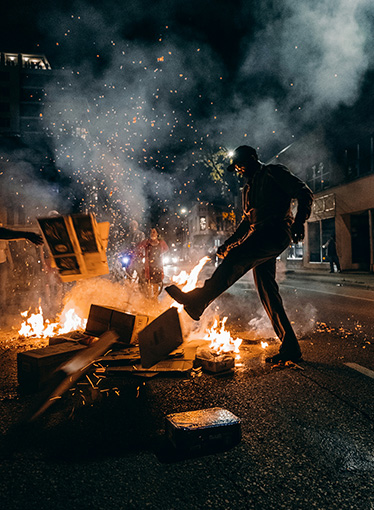Evacuations from Israel and High-Risk Locations Call +44 (0)1202 308810 or Contact Us →

Armenian Anti-Government Unrest, April 2018
19 Apr 2018
Extensive protests broke out in Yerevan, Armenia’s capital, from 13 April 2018 in response to parliament’s intended decision to appoint former President Serzh Sargysan as the country’s prime minister, with no opposition candidate. Due to significant constitutional reform in 2015, Armenia has shifted from a presidential system to a parliamentary republic, making the position of prime minister the most significant political office in place of the presidency.
Key Points
- Large crowds gathered across Armenia against the planned appointment of the former president as prime minister.
- Police initially acted with force to disperse protesters, however a containment strategy appears to be in place.
- Parliament acted to appoint the prime minister despite ongoing protests.
Situational Summary
Political: Extensive protests broke out in Yerevan, Armenia’s capital, from 13 April 2018 in response to parliament’s intended decision to appoint former President Serzh Sargysan as the country’s prime minister, with no opposition candidate. Due to significant constitutional reform in 2015, Armenia has shifted from a presidential system to a parliamentary republic, making the position of prime minister the most significant political office in place of the presidency.
As protests developed, security forces responded with significant displays of force against protesters, with at least 80 arrests officially confirmed to date. Armenian police officers in riot gear used stun grenades and teargas in efforts to disperse protesters on 16 April, with at least 50 protesters and police requiring hospital treatment. From 17 April, crowds totaling approximately 10,000 people staging sit-in pickets around key government buildings, were faced primarily with barbed wire and roadblocks to contain them. Prominent opposition leaders have called for the protests to escalate into wider industrial action and further actions to peacefully impede the function of government.
Despite the unrest, the Armenian parliament pressed ahead and appointed Sargysan on 17 April, with riot police and barbed wire preventing demonstrators’ attempts to disrupt proceedings.
Other cities around the country; including Gyumri, Ijevan, Vanadzor, Kapan, and Metsamor were also home to unrest, although of a less significant scale than in Yerevan. Protests also took place around Armenian embassies in countries with a significant diaspora community.
Solace Global Comment
The parliament’s decision to appoint Sargysan to the newly invigorated role of prime minister was not unforeseen. The position of president has a two-term limit, and the constitutional reform shifting presidential powers to the prime minister’s role has allowed a single person to remain at the head of government beyond this limit whilst retaining a veneer of democratic process. Indeed, international observers strongly suggested that significant vote tampering may have occurred during the 2015 referendum which ensured this change, likely on the orders of Sargysan or his party.
Despite this, until March 2018, Sargysan had specifically stated he would not seek the premiership following the implementation of reforms. Following the unopposed election of his replacement, Armen Sarkissian, to the presidency by parliamentary majority on 02 March 2018, Sargysan publically announced a willingness to consider the role of prime minister, but stopped short of announcing it as his objective. It was this escalation, from openly indicating no interest in the position, to running as an unopposed candidate, that led to the recent and ongoing wave of protests.
Considering that the Parliament pressed ahead with the appointment, regardless of the unrest, indicates that the political class maintain sufficient unity and momentum to enforce their will, and have also calculated that their decision to do so will not lead to further significant unrest. Initial observation of parliamentary support may suggest they are correct, both the government and primary opposition party approved the appointment of Sargysan, however there are indications that the protests have attracted members of all political parties concerned at the clear efforts by the former president to retain power. It is therefore a realistic probability that sufficient popular opposition exists to obstruct majority government.
The question of whether the unrest will continue partly depends on the conduct of the government against its opposition. The apparent shift in security tactics from confrontation to containment as the protests developed suggests that the government may seek a less aggressive method of restoring peace than it has previously done. It is likely that the use of more violent tactics could act to motivate and inspire further unrest. It is probable that permitting and containing peaceful protest will result in the demonstrations slowly reducing in intensity.
SECURITY ADVICE
Civil UnrestModerateTravellers are advised that protests are likely to continue for the foreseeable future in Yerevan and other major cities. Although levels of violence have so far remained relatively low, travellers are strongly advised to avoid any political events or demonstrations. An increased level of physical security should also be expected in the vicinity of government buildings, major state institutions, and large public areas where crowds may gather. Local media should be monitored for further developments.
For travel to Armenia, Solace Global would advise clients to employ enhanced security measures airport meet and greet and a locally vetted driver for the length of a visit should be considered effective mitigation against criminal and travel threats. Travel to disputed areas near the Armenia-Azerbaijani border should be undertaken with significant journey management and security precautions. All travellers should consider the use of travel tracking and intelligence software in order to permit effective implementation of duty of care, and to ensure travellers are kept up to date with developments to their security environment.